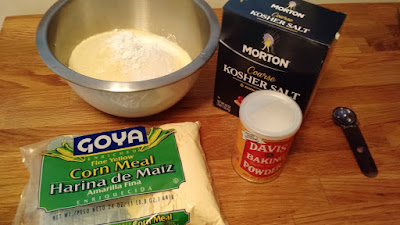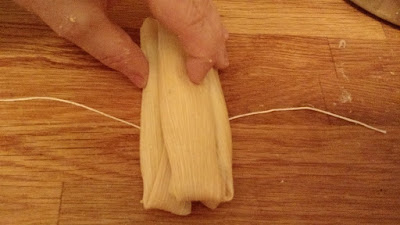While enjoying Christmas in Texas, we learned about the Hispanic tradition of making tamales for the holidays. It's an all-day activity that has simple enough steps that the whole family can get involved. That means a very long blog post, but the final product is well worth the effort.
There are two main types of tamales:
1)
Mexico-style - The base is masa harina (fine grind corn flour). Cooking method is steaming.
2)
Mississippi-style - The base is corn meal (coarse grind). Cooking method is boiling. Down South, we call 'em "hot tamales" because the boiling liquid is liberally spiced.
Note that neither of these are the sweet corn typically sold in supermarkets. Field corn (or maize) has large, starchy, and thick-shelled kernels. Some varieties can grow quite large.
A process called nixtamalization is used to remove the outer shell. This is a long soak in alkaline solution (calcium hydroxide, usually), followed by mechanical separation of the shell from the core.
After drying, the corn is milled into flour or meal. For today's recipe, we will be using fine grind for Mexico-style tamales.
You can also use coarse grind corn meal for Mississippi-style tamales (and grits, but that's another recipe).
Part 1:
Cook the meat that we will be using for the filling. I'm following Alton Brown's recipe for Turkey Tamales (
LINK) that begins with a spicy boil:
- 2 teaspoons chili powder
- 1 1/2 teaspoons cumin
- 1 teaspoon cayenne pepper
- 1 teaspoon dried oregano
- 1 teaspoon kosher salt
- 1 teaspoon freshly ground black pepper
Place 2-3 raw turkey legs into a large pot with your spice mixture.
Fill with enough water to cover the drumsticks.
Bring to a boil and let simmer for 2 hours. The meat will be fall-off-the-bone tender.
Pull the drumsticks from the vat of tastiness and allow to cool.
Just like with pulled pork (
shameless plug for one of our favorite recipes), shred the turkey meat.
Part 2:
Prepare the veggie base for the filling:
- 1 small onion, finely chopped
- 3 cloves garlic, minced
- 1 serrano chile, seeded and finely minced
- 1/4 cup vegetable oil
Heat the oil in a medium saute pan and cook down the onion until the edges just start to brown.
Toss in the garlic and pepper, and keep them moving (to prevent burnt garlic).
Salvage 1/2 cup of the turkey broth from earlier. Incorporate it and the shredded turkey meat into your veggie base. The meat will re-absorb much of the liquid . Let it simmer for a couple minutes, until there isn't any liquid on the bottom when you stir.
Part 3:
Next is the masa dough. If your corn husks will be small (like mine were), the masa:meat ratio will be higher. For this batch, I added 50% to Alton's recipe, for a total of:
- 6 cups masa harina
- 1.5 tablespoon kosher salt
- 3.5 teaspoons baking powder
- 3/4 cups lard
After mixing the dry ingredients, roll up your sleeves and kneed in the lard by hand. You'll know it's ready when the lard goes from clumpy to crumbly (see below).
Incorporate 3-4 cups of the turkey broth/liquid from earlier, and kneed with your hands. "Thick mashed potatoes" is the ideal consistency.
Part 4:
Rehydrate the corn husks in large container of water. Room temperature water works, but if you're in a hurry... hot water will expedite absorption.
Corn husks float, so add some weight. We had to get creative!
In preparation for Part 5, let's cut 12" (25 mm) segments of twine.
Also, prepare a pot for steaming. I used ~1 quart of water.
Part 5:
Tamales... Assemble!
It's been a long road, but we're almost done. Start with a corn husk that has been towel-dried. Drop in 1.0 - 1.5 tablespoons of masa dough.
Leave 1.5 - 2" at the pointy end. Also, press the center strip down, making a corny canoe.
Place 1.0 - 1.5 tablespoons of filling into the canoe. Spread the filling evenly.
Use the sides to press down the center strip and roll over the sides.
Just like wrapping a burrito, roll the masa to one side. Tuck the edge of the corn husk in, and roll the tamale. After it's cigar shaped, fold down the pointy end. Place the tamale face down, for future storage.
We will wrap 3 tamales into each bundle. Begin by placing the 12" segment of twine horizontally. The folded end of each tamale will be facing up and inward.
Add the third tamale, and tie the twine using your favorite knot. That Boy Scout merit badge finally paid off.
Toss the bundle of joy into the steamer basket and repeat a billion times.
Put the pot on the stove, heat until the water starts to boil, and set to LOW for 1.5 hours.
Tamales are great by themselves, but they will benefit from some beans, rice, chips, queso, guacamole, or salsa. We had black-eyed peas and some tomatillo salsa verde for our New Year's celebration... and that paired excellently.
















































































